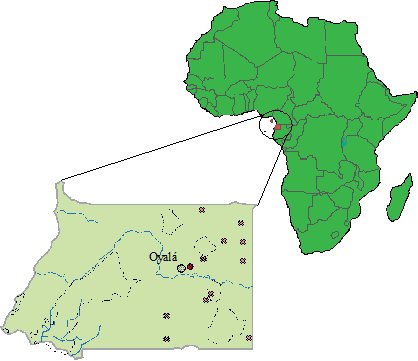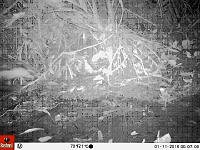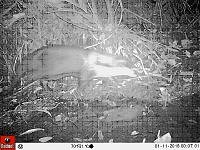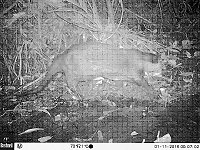IUCN/SSC Otter Specialist Group Bulletin

|
©IUCN/SCC Otter Specialist Group Volume 33 Issue 2 (October 2016) Citation: Brzeski, KE, Wolfe,
JD, Ebana Ebana, C, Cooper, JC, and Powell, LL (2016). Camera Sighting of Congo Clawless Otter in the Midst of a Rapid Development on Mainland Equatorial Guinea. IUCN Otter Spec. Group Bull.
33 (1): 96 - 101 Camera Sighting of Congo Clawless Otter in the Midst of a Rapid Development on Mainland Equatorial Guinea Kristin E. Brzeski1,2*, Jared D. Wolfe1,2, Cayetano Ebana Ebana5, Jacob C. Cooper1,6,7, and Luke L. Powell1,8,9
11Biodiversity Initiative, 133 Washington St., Belmont, MA 02478, USA. http://biodiversityinitiative.org/ |
| (Received 27th October 2016, accepted 12th December 2016) |
| Abstract: Mainland Equatorial Guinea is undergoing rapid infrastructure development driven by the discovery of large oil reserves within the country’s maritime political boundaries. The country recently began implementing Horizonte 2020, a national development project that includes a vast highway network and creation of a new capital city. Road construction has quickly increased access to previously remote forest regions, resulting in intensified bushmeat hunting and logging. The status of sensitive wildlife, such as river otters, is poorly known but populations are likely susceptible to demographic declines due to rapid development and habitat loss. In January 2016, the Biodiversity Initiative, a non-governmental organization conducting wildlife surveys on mainland Equatorial Guinea, captured an image of a Congo clawless otter (Aonyx congicus) in primary forest. This detection represents the first attempt in recent years to assess otters in Equatorial Guinea, and combined with future work, will serve as a benchmark for assessing Congo clawless otter vulnerability to development in Equatorial Guinea. |
| Keywords: Aonyx congicus, Congo clawless otter, camera-trap, Equatorial Guinea |
| Française | Español |
INTRODUCTION
The Republic of Equatorial Guinea is an incredibly biodiverse country located in the Congo Basin, hosting the fourth highest species richness of primates in Africa (Chapman et al., 1999). Equatorial Guinea consists of a mainland section known as Río Muni and two islands – Bioko and Annobón. The mainland of Equatorial Guinea still has relatively large tracts of primary forest which provide habitat to species of conservation concern such as endangered western lowland gorilla (Gorilla gorilla gorilla), endangered central chimpanzee (Pan troglodytes troglodytes), and forest elephant (Loxodonta cyclotis) (Murai et al., 2013; IUCN 2015). The presence of large, sensitive megafauna, indicates that much of the forested mainland of Equatorial Guinea hosts intact ecosystems. Although intact ecosystems may still exist on Río Muni, little is known regarding the status or distribution of otters throughout the country.
There are two river otter species on mainland Equatorial Guinea: spotted-necked otters (Hydrictis maculicollis) and Congo clawless otters (Aonyx congicus). The island of Bioko may have hosted otters in the past, but more likely the Equatoguinean island was never colonized by otters and early explorer reports were erroneous (Hoffman et al., 2015). Spotted-necked and Congo clawless otters were both recently listed as near-threatened on the IUCN Redlist due to habitat loss and development which has made previously remote regions more accessible to human use (Jacques et al., 2015; Reed-Smith et al., 2015). Loss of habitat and increased access to remote areas are the primary threats to wildlife in mainland Equatorial Guinea, where offshore oil reserves have fueled precipitous economic growth, leading to increased development within the historically undeveloped mainland. The government’s most ambitious project is the ongoing construction of a new capital city, Oyalá, in the heart of the mainland, resulting in the loss of primary forest (Sackur, 2013; Zvomuya, 2014). Ongoing development and increased human resource extraction is leveraging huge pressure on Equatoguinean wildlife and contributing to the ongoing “bushmeat crisis” in Central Africa (Barnes, 2002).
Although otters are not a common bushmeat species, both spotted-necked and Congo clawless otters have been detected at bushmeat markets in Equatorial Guinea and neighboring countries (Fa and Yuste, 2001; Fa et al., 2004). We are at the risk of otters being extirpated from portions of Río Muni before knowing anything about their distributions, ecology, or habitat requirements. This is especially true for Congo clawless otters, of which very little is known (Jacques et al., 2002, 2009).
The Biodiversity Initiative, an NGO that has been working in Equatorial Guinea since 2013, developed in response to the furious pace of development in the country, and for the desire to understand more about the ecology of Central African wildlife and ultimately to conserve it. During our 2016 field season, we deployed camera-traps in primary and secondary lowland rain forest near the new capital city, which is also where a new flagship university is being built: the Afro-American University of Central Africa (AAUCA). Our objectives were to establish baseline data on species distributions before development of the new capital and university is completed.
METHODS AND DETECTION RESULTS
Our study site was located next to the AAUCA campus, within the new capital city of Oyalá at 1.604229º, 10.857476º (Fig. 1). The surrounding forest was a matrix of secondary forest of varying ages and quality, and large patches of primary forest. Although there was evidence of hunting in both primary and the secondary forests, signs of human use greatly decreased in primary forests. We deployed eight Bushnell 12MP Trophy Cam HD Essential Low Glow trail cameras in primary habitat. We left the camera trap deployed for a minimum of 10 camera nights and baited each camera station with sardine cans.

|
| Figure 1. Map of mainland Equatorial Guinea. Protected areas are outlined in black; the study site and city of Oyalá, where construction of the new university is occurring, is marked; our camera trap capture of a Congo clawless otter is marked by the red circle; orange Xs mark otter tracks detected in a 2011 survey by Murai et al., 2013. |
We detected one adult Congo clawless otter at a camera adjacent to a low-flowing stream (Fig. 2). Detection was on January 1, 2016, 07:00; this is the dry season in Río Muni and water levels were low. There were three images, with a clear full body shot, which revealed evidence that the otter was potentially gravid or nursing given the sagginess of its abdominal region. The camera trap was located at 1.613850º, 10.878850º, with an elevation of 653m.
DISCUSSION
Little is known about Congo clawless otter in Equatorial Guinea. Otter tracks were detected in transect surveys conducted in Equatorial Guinea in 2011 (Murai et al., 2013), and combined with our detection, it demonstrates otters still exist in the heart of Río Muni despite large scale development in the region (Fig. 1). Interestingly, there are no otter detections on the west side of the country, despite large estuaries persisting near the coast. Future work will focus on setting cameras up more extensively along rivers at our Oyalá study plot and in secondary forests to assess if disturbance reduces otter detections. Given we had cameras deployed for a relatively short amount of time, it is promising we detected a rare otter, even if it was only one detection event. Ideally we are observing a resilient Congo clawless otter population, and not the last remnants of a disappearing population due to disturbance. Additional monitoring and active surveys for otter sign will elucidate this further.
Acknowlgfbvvvvqedgements: We sincerely thank the StoneHill Education and the Afro-American University of Central Africa for logistical support. We also thank Mizuki Murai for providing locations for river otter tracks detected during their country-wide transects..
REFERENCES
Barnes, R. (2002). The bushmeat boom and bust in west and central Africa. Oryx, 36: 236–242.
Chapman, C. A., A. Gautier-Hion, A., Oates, J. F., Onderdonk. D. A. (1999). African primate communities: determinants of structure and threats to survival. Pages 1-37 in Fleagle, J. G, Janson, C., Reed K. E., (Eds). Primate communities. Cambridge University Press, Cambridge.
Fa, J. E., Yuste, J. G. (2001). Commercial bushmeat hunting in the Monte Mitra forests, Equatorial Guinea: extent and impact. Animal Biodiversity and Conservation, 24(1): 31-52.
Fa, J. E., Johnson, P. J., Dupain, J., Lapuente, J., Köster, P., Macdonald, D. W. (2004). Sampling effort and dynamics of bushmeat markets. Animal Conservation, 7(4): 409-416.
Hoffmann, M., Cronin, D. Gail Hearn, G., Butynski, M. (2015). A review of evidence for the presence of Two-spotted Palm Civet Nandinia binotata and four other small carnivores on Bioko, Equatorial Guinea. Small Carnivore Conservation, 52 & 53: 13–23
IUCN (2015). The IUCN Red List of Threatened Species. Version 2015-4. <http://www.iucnredlist.org>. Downloaded on 1 Jaunary 2016.
Jacques, H., Moutou, F., Alary, F. (2002). On the tracks of the Congo clawless otter (Aonyx congicus) in Gabon. IUCN Otter Specialist Group Bulletin, 19: 40–50.
Jacques, H., Veron, G., Alary, F., Aulagnier, S. (2009). The Congo clawless otter (Aonyx congicus) Mustelidae: Lutrinae): a review of its systematics, distribution and conservation status. African zoology, 44: 159-170.
Jacques, H., Reed-Smith, J., Davenport, C., Somers, M. J. (2015). Aonyx congicus. The IUCN Red List of Threatened Species 2015: e.T1794A14164772. http://dx.doi.org/10.2305/IUCN.UK.2015-2.RLTS.T1794A14164772.en. Downloaded on 21 September 2016.
Murai, M, Ruffler, H, Berlemont, A, Campbell, G, Esono, F, Agbor, A, Mbomio, D, Ebana, A, Nze, A and Kühl, HS (2013). Priority areas for large mammal conservation in Equatorial Guinea. PloS one, 8(9): e75024.
Reed-Smith, J., Jacques, H., Somers, M. J. (2015). Hydrictis maculicollis. The IUCN Red List of Threatened Species 2015: e.T12420A21936042. http://dx.doi.org/10.2305/IUCN.UK.2015-2.RLTS.T12420A21936042.en. Downloaded on 21 September 2016.
Sackur, S. (2013). Equatorial Guinea: Obiang’s future capitol, Oyalá. BBC News accessed from www.bbc.co.uk on 30 January 2013
Zvomuya, F. (2014). On a whim: Equatorial Guinea building new capital city in the middle of the rainforest. Mongabay. [Online.] Available at http://news.mongabay.com/2014/07/on-a-whim-equatorial-guinea-building-new-capital-city-in-the-middle-of-the-rainforest/
Résumé : Observation par Camera de Loutres du Congo au milieu de la Guinee Equatoriale Continentale Soummise à un rapide Developpement
La Guinée équatoriale continentale est soumise à un rapide développement d’infrastructures piloté par la découverte d’importantes réserves de pétrole dans les eaux territoriales du pays. Le pays a récemment commencé à mettre en œuvre Horizonte 2020, un projet national de développement qui inclue un vaste réseau d’autoroute et la création d’une nouvelle capitale. La construction de routes a rapidement augmenté l’accès au région forestière jusqu’à présent reculées, entrainant une intensification de la chasse d’animaux sauvages et de l’exploitation forestière.
L’état de la faune sauvage, tel que les loutres de rivière, est faiblement connu à ce jour mais ces populations sont fortement enclines à subir un déclin démographique dû à ce développement rapide et à la perte de leur habitat.
En Janvier 2016, l’Initiative Biodiversité, une organisation non gouvernementale conduisant une enquête de la faune de la Guinée équatoriale continentale, a photographié une loutre du Congo (Aonyx congicus) dans la forêt primaire. Cette preuve représente la première tentative de ces dernières années pour évaluer la population de loutre du Congo, qui combinée avec des travaux futurs, servira de repère pour le suivi de la vulnérabilité de ces loutres du Congo vis à vis du développement de la Guinée équatoriale.
Revenez au dessus
Resumen: Registro con Cámara-Trampa, de la Nutria sin Garras del Congo, en medio de un Rápido Desarrollo en Guinea Ecuatorial
Guinea Ecuatorial (parte continental) está teniendo un rápido desarrollo de infraestructura, motivado por el descubrimiento de grandes reservas de petróleo dentro de los límites marítimos del país. El país recientemente empezó a implementar Horizonte 2020, un proyecto nacional de desarrollo que incluye una vasta red de autopistas y la creación de una nueva ciudad capital. La construcción de caminos ha incrementado rápidamente el acceso a regiones selváticas previamente remotas, resultando en la intensificación de la caza de carne silvestre y la tala. El estatus de la fauna vulnerable, como las nutrias de río, es pobremente conocido, pero las poblaciones son probablemente susceptibles a declinaciones demográficas debido al rápido desarrollo y la pérdida de hábitat. En Enero de 2016, la Iniciativa de Biodiversidad, una organización no-gubernamental que conduce relevamientos de vida silvestre en Guinea Ecuatorial continental, capturó una imagen de una nutria sin garras del Congo (Aonyx congicus) en bosques primarios. Esta detección representa el primer intento en años recientes, de evaluar a las nutrias en Guinea Ecuatorial, y combinado con trabajos futuros, va a servir como un hito para evaluar la vulnerabilidad de la nutria sin garras del Congo, respecto al desarrollo en Guinea Ecuatorial.
Vuelva a la tapa


